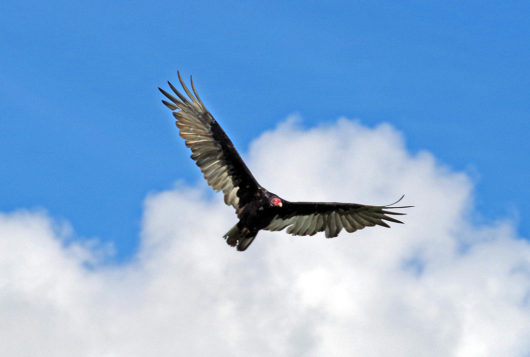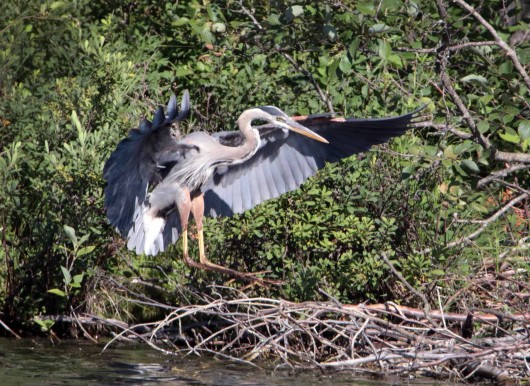Gulls know how to do the flock thing for sure. Pity the next human visitors to that raft. Hopefully they came with a mop. It does make you wonder though. It’s not like someone spread a breakfast of bagel bits on the raft and hollered “come and get it.”
You hear that distinctive wail of the loon and you never figure they’d gang up or have a party. But they do. And here on Long Lake.
Then there are the true loners, like this Great Blue Heron walking slowly through the shallows looking for tasty morsels.
Apparently if the vantage point isn’t quite right, they’ll try for a better view, though.
The Eastern Kingbird is often seen hunting solo for insects. But they work in pairs to feed their young.
Kingbirds don’t look particularly menacing. But if you come near their nest before the chicks fledge, look out. How do I know? They nested again this year in the cupholder on our dock bench.
They sort of fake you out because they tolerate your presence while they sit on the eggs. But once the eggs hatch, look out. Once the eggs hatch and you’re just minding your own business quietly trying to unmoor or moor your pontoon boat’s dock lines these birds are fierce. And they don’t just fly around above and squawk menacingly. They dive bomb right at your head and aren’t satisfied until they’ve actually hit it. I thought for awhile if you didn’t talk and if you didn’t look in their direction, they’d leave me alone. They proved me wrong on both strategies. We surrendered our dock bench to them for the duration. But we weren’t willing to surrender our boat rides and so we paid the price. No injuries though. Not to us and not to the Kingbirds.
We see Flickers alone or in pairs, often pecking around in the dirt looking for bugs and other protein.
This guy was just resting a bit, near as we could tell.
There are some birds that all Long Lakers can identify at a glance, like this Gull giving a Bald Eagle a hard time.
The Gull knew a threat, to young we assume, and went after the Eagle. There were some interesting aerobatics. At one point the Gull bounced off the Eagle, doing no apparent damage to either.
Cormorants seem to be more frequent visitors to Long Lake. We may even have a few permanent resident Cormorants this year.
Long Lakers aren’t freaking out though. Sure, Cormorants fish almost as effectively as Jeff does. But we don’t get much by way of walleye stocking these days. And besides a few Cormorants just do their bit to increase our lake’s biodiversity.
Speaking of biodiversity, please leave a comment if you recognize who this pair is. We spotted them in Ghost Bay on August 18th.
I thought they were adolescent mallards. We did have a brood of mallard chicks this year. But these upper bills have an overlapping point at the end, more like a merganser and unlike a mallard. If they are mergansers, maybe in their eclipse plumage, they must have forgotten to check the calendar. Plus they must have lost their GPS because we should be seeing Common Mergansers only briefly in the early spring or late fall. Please leave a comment if you recognize this pair.
We’re getting into the migration season again on the lake. It’s such a fun season and we’re fortunate that so many species decide to land and spend time on our lake. Actually, though, I must betray my biologically incorrect bias and confess that if the Canada Geese would just keep flying I’d be fine with that.



























